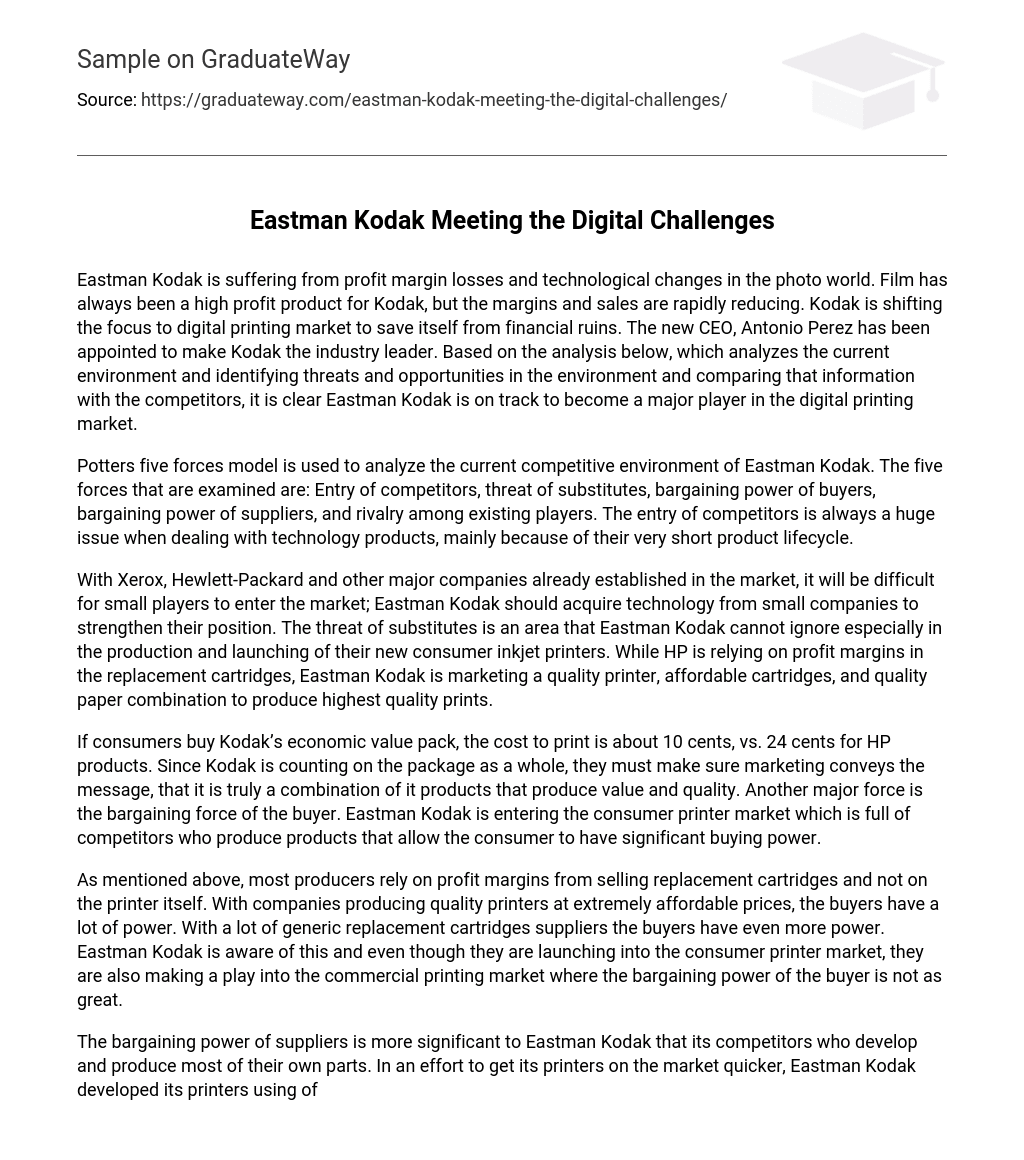Eastman Kodak is currently experiencing financial difficulties and technological changes in the photography sector. Although film has traditionally been a profitable product for the company, its sales and profit margins are decreasing rapidly. To avoid potential financial disaster, Kodak is concentrating on the digital printing market. The appointment of Antonio Perez as CEO aims to reshape Kodak into a prominent player within the industry. A thorough evaluation of the present market conditions, which involves identifying both threats and opportunities while comparing them to competitors, indicates that Kodak has great potential to establish itself as a major contender in the digital printing market.
Potters five forces model is used to analyze the current competitive landscape of Eastman Kodak. It examines five key factors: the entry of competitors, threat of substitutes, bargaining power of buyers and suppliers, and rivalry among current players. When it comes to technology products, the short lifespan of these products makes the entry of competitors a major challenge.
Smaller players face a challenge entering the market with established companies like Xerox and Hewlett-Packard already present. To strengthen their position, Eastman Kodak should acquire technology from smaller companies. The threat of substitutes is an area that Eastman Kodak must consider, especially in the production and launch of their new consumer inkjet printers. HP relies on profit margins from replacement cartridges, whereas Eastman Kodak emphasizes a combination of a quality printer, affordable cartridges, and quality paper to achieve the best prints.
If consumers purchase Kodak’s economic value pack, they will only spend around 10 cents per print, while HP products cost about 24 cents. Kodak relies on the package as a whole and thus needs to ensure that its marketing effectively communicates that the combination of its products offers both value and quality. Additionally, the buyer holds considerable bargaining power in this highly competitive consumer printer market that Eastman Kodak is entering.
As stated earlier, the majority of producers depend on profits generated from the sale of replacement cartridges rather than the actual printer. Given that companies offer high-quality printers at exceptionally reasonable prices, buyers have significant influence. Moreover, with numerous suppliers of generic replacement cartridges, buyers possess even more power. Eastman Kodak recognizes this and is entering both the consumer printer market and the commercial printing market, where the buyer’s bargaining power is comparatively lower.
Eastman Kodak places a higher emphasis on the bargaining power of suppliers compared to its competitors due to their different production strategies. While Eastman Kodak opts for off-the-shelf parts to expedite printer production, its competitors are self-reliant and manufacture their own components. To achieve this approach, Eastman Kodak collaborates with chip-design specialists as technology partners instead of starting from scratch. This decision enables faster development and cost reduction but also grants suppliers greater influence in terms of purchasing power for printer manufacturing parts.
Despite potential risks, Kodak’s choice to internally develop and manufacture the majority of its components, as opposed to other market players, has the potential for lasting advantages. Among the five forces impacting the industry, competition among rivals is particularly pivotal. The market is intensely competitive due to battles for extra shelf space, bundling printers with computers, and employing discounts and rebates. In terms of economics, Kodak stands out from its competitors primarily due to disparities in the business cycle stage.
Eastman Kodak, a well-established company, has transitioned its focus from film to digital printing. Although they are currently trailing their established competitors, Kodak CEO Antonio Perez believes this can be beneficial. He perceives it as an opportunity to revolutionize the industry’s business model and tackle consumer discontent with the excessive expense of ink. Another economic issue for the company is labor. To avoid higher labor expenses in the U.S., Kodak has relocated a substantial portion of its workforce to Mexico.
The future of Kodak will be heavily influenced by the technological environment. Of particular concern is the research and development department, which, although well-led and with clear objectives, relies on technology partners for parts. This reliance makes it easier for competitors to imitate their products. However, this dependence on external sources also presents both threats and opportunities for Eastman Kodak.
Kodak faces several significant threats, including the formidable market position of HP and their ability to swiftly respond with competitive products. This poses a risk to any product released by Kodak. Another notable challenge for Kodak is entering the consumer printer market in a substantial manner. Presently, Kodak does not have a major presence in this market and may encounter difficulties in achieving its objective. Although Kodak has a strong foothold in the film and digital camera markets, both the consumer printer and commercial printer markets are controlled by established competitors.
The primary concern is the significant disadvantage of entering the market two decades after the leaders. However, amidst the threats, there are opportunities available to Kodak. A potential avenue lies in the commercial printing sector, where Kodak could potentially capture a substantial market share by introducing a top-notch printer and offering replacement cartridges at a more affordable price. Hence, Kodak holds the potential to establish itself as a key participant in the digital printing industry.
They must remain committed to their current goal of creating a printer that delivers the utmost quality prints and ensuring that it is financially accessible to the average consumer. Furthermore, they should focus on advancing technology for the commercial printing industry. Regularly assessing their activities and overall direction is vital for staying on course. It is equally important to align with CEO Antonio Perez’s vision and prioritize ongoing research and development initiatives.





